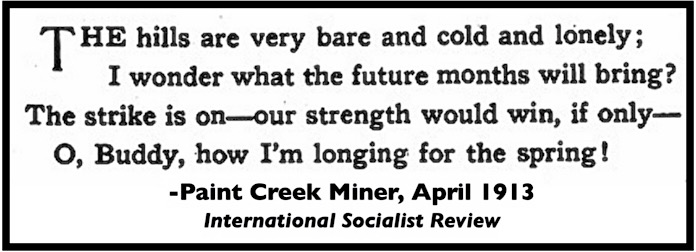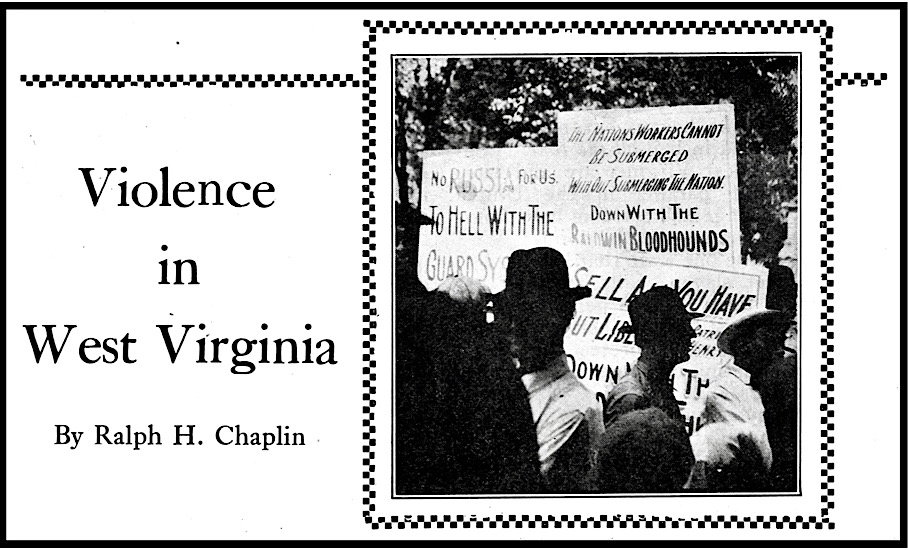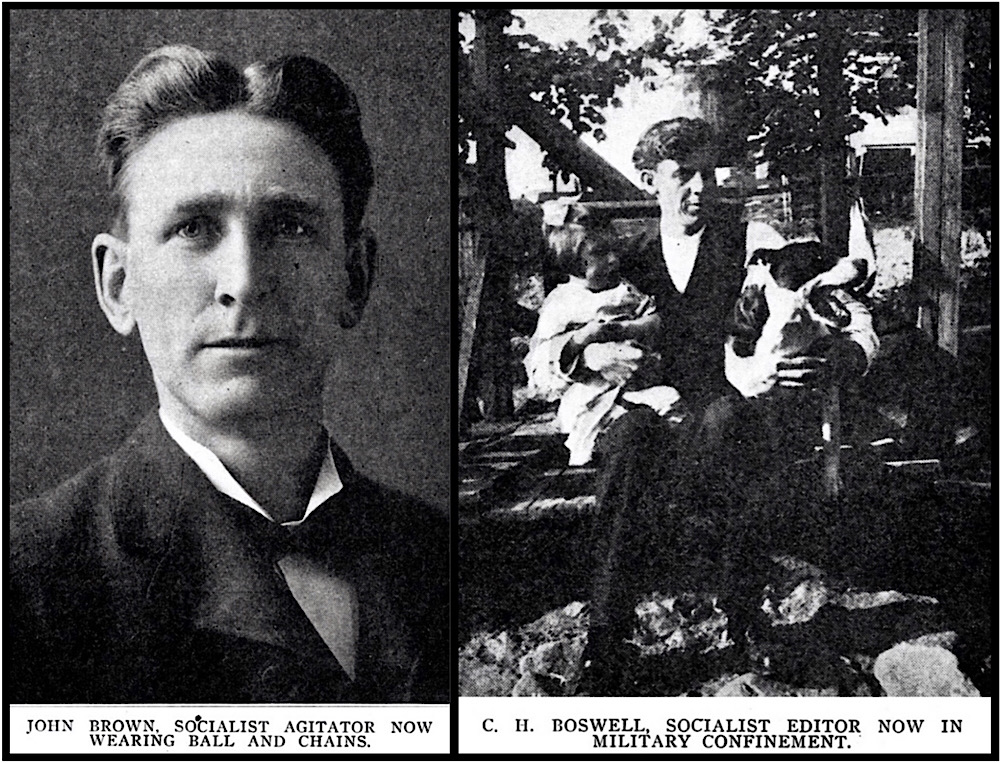 —————
—————
Hellraisers Journal – Wednesday April 2, 1913
Ralph Chaplin on the Attack by the Bull Moose Special Upon Strikers’ Colony
From the International Socialist Review of April 1913:
[Part II of III.]
The operators, realizing that violence has always been their big trump, thought they would have everything their own sweet way when trouble started. Everything was in their favor-armed guards and regiments of militiamen-so why should they not feel confident? But it is evident that the miners have fooled them. The miner knew the hills better than the blood-hounds that were sent to track them down. After a few months of it, the odds are just about even, and the fight is not half over. Soldiers in the strike zone are becoming uneasy and are using the slightest excuse to make a getaway. Many of the guards have deserted their posts of duty in a panic. One hundred and fifty of them have paid for treason to their class with their lives! They are in mortal fear of the time when the bleak hillsides will be covered with greenery-when “the leaves come out!“
The miners have been hounded into the using of violence. Just an instance in which the above-mentioned armored train figures conspicuously: This train is called, for some reason or other, the Bull Moose Special. Needless to state, it is thoroughly hated by the miners. The engineer and fireman and others of the train crew are reported to be extremely proud of the union cards they carry. This hellish contraption was a lovely plaything to put into the hands of the cut-throat, coyote-hearted guards and, like children with a new pop-gun, they were simply aching for an opportunity to use it against the strikers. The opportunity soon presented itself. Just how it came about nobody seems to know. The guards claim that some of the miners had fired into an ambulance carrying wounded mine-guards to the hospital. The strikers claim that the train was first used to avenge the death of a couple of guards who had been held to account for insulting some of the girls in the tent village. I, myself, have spoken with miners who claim to have been eye-witnesses to the insulting of these girls.
Mine guards are noted for their inhuman and brutal treatment of the women of the miners. Their authoritative positions often gave them advantages over the helpless women, especially in the absence of the men, and the full record of their unrestrained animal viciousness will never be written. Between the miners and the guards there is an open war to the knife. More than once these Kanawha cossacks have evicted mothers, in the pangs of childbirth, from company houses, and children have been born in the tents of the strikers while the murderous bullets of the guards were whistling and zipping through the canvas. At all events these cut-throats of the coal operators had the long wished for chance to use the Bull Moose special. They would have their revenge.
So in the dead of night, and with all lights extinguished, the Death Train drew up over the sleeping tent village at Holly Grove and opened fire with machine gun and rifle. Miners’ huts were torn to splinters and tents were riddled with bullets. One woman had both legs broken by the murderous rain of lead; and a miner, holding an infant child in his arms and running from his tent to the shelter of a dugout, fell, seriously wounded. The baby was, by some miracle, unhurt, but three bullet holes had tattered the edge of its tiny dress. Men, women and children ran hastily through the dark night seeking the cold security of the woods. The miners, as could be expected, were desperate enough to do most anything and returned the fire as best they could. Bonner Hill, sheriff of Kanawha county, who was only elected by a small and suspicious majority over Tincher the Socialist, candidate, was on the train, and it is claimed by the train crew that it was he who gave the order to fire the first murderous volley.
In the morning the miners attempted to return to the ruins of their “homes,” but the mine-guards on the hillsides continued to fire upon them in order to drive them back. All day and all night the battle raged, but the guards had the advantage. So on the following morning the miners decided to remove to a less exposed location. Thereupon the little band of valiant but homeless wanderers started for Mucklow, with their few belongings on their backs. But their troubles were not yet over. They had not traveled far when their march was opposed by the cowardly mine guard captain, Fred Lester and his gang. The guards unexpectedly opened fire at first sight.
The miners surrounded their women and children and the situation began to look serious. Captain Lester was getting a machine gun ready for use when the miners let loose a well aimed broadside in the general direction of that prolific little blood spiller. The gallant cockroach captain was unaccustomed to do battle with men who would fight back. So he ordered a hasty retreat, and he and his delectable gang broke for the tall timber, leaving the machine gun to the miners. It is reported that Captain Lester led the retreat by about six hundred yards. A short time later the weary and wayworn band of hounded outcasts were completely surrounded by the uniformed scab-herders of the operators-the militiamen. Seventy-five miners were arrested and thrown into bull-pens, where they are now awaiting court martial trials.
For a few days after this episode Hell broke loose in the Kanawha valley. Ugly rumblings of rage were heard all over the state and even from nearby states came rumors of revolt. Armed miners poured into the trouble district from all sides and it is reported that an attempt was made to destroy the hated Death Train. In a pitched battle sixteen men were killed, or rather four men and twelve mine guards. The miners fought like demons, at times standing directly under the death-spitting machine guns of the train, and firing into the loop holes at the guards.
After the battle the Bull Moose Special was just about as much shot to pieces as is the record of Roosevelt, its namesake. More miners were arrested; among whom was John Brown, organizer for the Socialist party. Mother Jones, C. H. Boswell, Paul Paulsen and Charles Batley were also arrested, but in Charleston, as “accessories before the fact.” Charleston happens to be over twenty miles from the martial law zone. So these people were kidnapped and spirited away to that greed-sanctified section, there to await a military trial, with five distinct charges placed against them-charges varying in gravity from stealing machine guns to murder! Writs of habeas corpus were secured and the “felonious culprits” were brought to Charleston under a heavy military guard. They were brought into the dimly lighted court room to witness a farcical drama of “Justice.” White-haired, venerable Mother Jones and the rest of the undesirables listened with smiles of unconcern while the Supreme Court declared that the military authorities have a perfect right to “hold and detain” the accused parties until peace could be restored.
It was hoped by some that martial law would be held to be unconstitutional. The Supreme Court, however, refused to consider the question of its legality. Attorney Harold W. Houston, of Charleston, rested great hopes on the successful outcome of the struggle to wring justice from the courts. He is a splendid fighter and an excellent lawyer, but it is evident that even lawyers are learning things these days. Socialists will do well to watch closely the result of these trials and the after effects. They are bound to prove interesting.
[Emphasis and paragraph breaks added.]
~~~~~~~~~~~~~~~~~~~~~~~~~
SOURCE & IMAGES
International Socialist Review
(Chicago, Illinois)
-April 1913, page 729
https://www.marxists.org/history/usa/pubs/isr/v13n10-apr-1913-ISR-riaz-ocr.pdf
See also:
Hellraisers Journal: From the International Socialist Review:
Ralph Chaplin on Military Violence Against Striking Miners, WV
Part I
Tag: Thomas Tincher
https://weneverforget.org/tag/thomas-tincher/
Tag: Harold Houston
https://weneverforget.org/tag/harold-houston/
Wobbly
The Rough and Tumble Story of an American Radical
-by Ralph Chaplin
University of Chicago Press, 1948
Full view:
https://catalog.hathitrust.org/Record/001137040
Chapter 11, page 116: The Kanawha Miners’ Strike
https://babel.hathitrust.org/cgi/pt?id=uc1.31210001076247&view=2up&seq=126
Tag: West Virginia Court Martial of Mother Jones + 48 of 1913
https://weneverforget.org/tag/west-virginia-court-martial-of-mother-jones-48-of-1913/
Tag: Paint Creek-Cabin Creek Strike of 1912-1913
https://weneverforget.org/tag/paint-creek-cabin-creek-strike-of-1912-1913/
Tag: Ralph Chaplin
https://weneverforget.org/tag/ralph-chaplin/
~~~~~~~~~~~~~~~~~~~~~~~~~
Coal Miners Grave – Idaho Silver Hammer Band
Lyrics by Hazel Dickens


